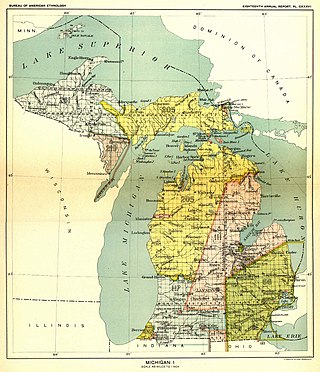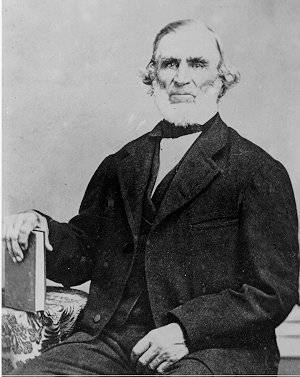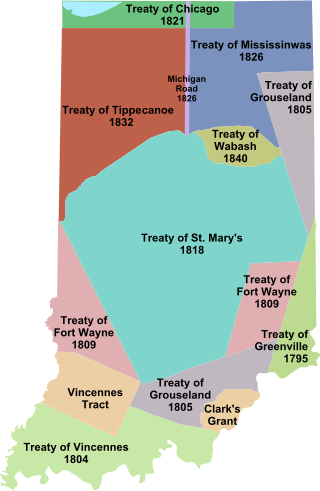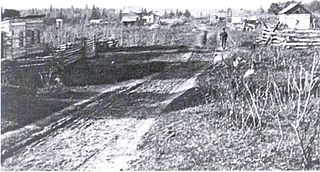
The Sauk or Sac are Native Americans and Indigenous peoples of the Northeastern Woodlands. Their historical territory was near Green Bay, Wisconsin. Today they have three tribes based in Iowa, Kansas, Nebraska, and Oklahoma. Their federally recognized tribes are:

Indian Territory and the Indian Territories are terms that generally described an evolving land area set aside by the United States government for the relocation of Native Americans who held original Indian title to their land as an independent nation-state. The concept of an Indian territory was an outcome of the U.S. federal government's 18th- and 19th-century policy of Indian removal. After the American Civil War (1861–1865), the policy of the U.S. government was one of assimilation.

The Territory of Michigan was an organized incorporated territory of the United States that existed from June 30, 1805, until January 26, 1837, when the final extent of the territory was admitted to the Union as the State of Michigan. Detroit was the territorial capital.

Lucius Lyon was a U.S. statesman from the state of Michigan. Along with Louis Campau, Lucius Lyon is remembered as one of the founding fathers of Grand Rapids, Michigan, the state's second-largest city. A Democrat, he served as a Delegate to the U.S. House from Michigan Territory (1833–1835), a U.S. Senator from Michigan (1837–1839), and a member of the U.S. House of Representatives from Michigan's second congressional district (1843–1845).

The Odawa are an Indigenous American people who primarily inhabit land in the Eastern Woodlands region, now in jurisdictions of the northeastern United States and southeastern Canada. Their territory long preceded the creation of the current border between the two countries in the 18th and 19th centuries.
Billy Caldwell, known also as Sauganash, a variant spelling of Zhagnash meaning British in the Potawatomi language, was a Métis fur trader who was commissioned captain in the Indian Department of Canada during the War of 1812, and fought alongside Tecumseh at the Battle of Frenchtown and likely all the subsequent battles until their defeat at the Battle of the Thames. In 1829 and 1833, he negotiated treaties on behalf of the United Nations of Chippewa, Ottawa and Potawatomi with the United States, as a leader of a Potawatomi and led his band to Trader's Point, Iowa Territory, modern day Council Bluffs. He had worked to gain the boundary long promised by the British between white settlers and Indians, but never achieved it and instead acquiesced to American purchase and Indian removal, leading his followers personally across the Mississippi, as evidenced by his signing of the 2nd Treaty of Prairie du Chien and his inclusion on the Removal Muster Rolls of 1837.

The Treaty of Chicago may refer to either of two treaties made and signed in the settlement that became Chicago, Illinois between the United States and the Odaawaa, Ojibwe, and Bodéwadmi Native American peoples. The first was in 1821 and the second in 1833.

The Treaty of Washington is a treaty between the United States and representatives of the Ottawa and Chippewa nations of Native Americans. With this treaty, the tribes ceded an area of approximately 13,837,207 acres in the northwest portion of the Lower Peninsula of Michigan and the eastern portion of the Upper Peninsula of Michigan. This area represents approximately 37% of the current land area of the state of Michigan.

The Grand Traverse Band of Ottawa and Chippewa Indians is a federally recognized Native American tribe located in northwest Michigan on the Leelanau Peninsula. Sandra Witherspoon is the current tribal chairperson, elected in May 2024 to a four-year term after succeeding David Arroyo, who served a single term from 2020 to 2024.

Rix Robinson was an Amercan fur trader and politician. He was the first permanent Euro-American settler of Kent County, Michigan, a representative to the state constitutional convention of 1850 and a state senator.

The Little Traverse Bay Bands of Odawa Indians is a federally recognized Native American tribe of Odawa. A large percentage of the more than 4,000 tribal members continue to reside within the tribe's traditional homelands on the northwestern shores of the state of Michigan's Lower Peninsula. The historically delineated reservation area, located at 45°21′12″N84°58′41″W, encompasses approximately 336 square miles (870 km2) of land in Charlevoix and Emmet counties. The largest communities within the reservation boundaries are Harbor Springs, where the tribal offices are located; Petoskey, where the Tribe operates the Odawa Casino Resort; and Charlevoix.
Anishinaabe tribal political organizations are political consortiums of Anishinaabe nations that advocate for the political interests of their constituencies. Anishinaabe people of Canada are considered as First Nations, and of the United States as Native Americans.

Little River Band of Ottawa Indians is a federally recognized Native American tribe of the Odawa people in the United States. It is based in Manistee and Mason counties in northwest Michigan. It was recognized on September 21, 1994.
Carey Mission was established in December 1822 by Baptist missionary Isaac McCoy among the Potawatomi tribe of American Indians on the St. Joseph River near Niles, Michigan, United States. It was named for English Baptist missionary William Carey. Its official nature and reputation made it a headquarters for settlers and an edge of the American frontier.

Indian removals in Indiana followed a series of the land cession treaties made between 1795 and 1846 that led to the removal of most of the native tribes from Indiana. Some of the removals occurred prior to 1830, but most took place between 1830 and 1846. The Lenape (Delaware), Piankashaw, Kickapoo, Wea, and Shawnee were removed in the 1820s and 1830s, but the Potawatomi and Miami removals in the 1830s and 1840s were more gradual and incomplete, and not all of Indiana's Native Americans voluntarily left the state. The most well-known resistance effort in Indiana was the forced removal of Chief Menominee and his Yellow River band of Potawatomi in what became known as the Potawatomi Trail of Death in 1838, in which 859 Potawatomi were removed to Kansas and at least forty died on the journey west. The Miami were the last to be removed from Indiana, but tribal leaders delayed the process until 1846. Many of the Miami were permitted to remain on land allotments guaranteed to them under the Treaty of St. Mary's (1818) and subsequent treaties.

Cobmoosa, or Weebmossa meaning "Great Walker", was an Odawa leader who lived in a Native American village at the mouth of the Flat River at the present-day city of Lowell, Michigan until 1858.

The Burt Lake Burn-Out was a forced relocation of the Burt Lake Band of Chippewa and Ottawa Indians in northern Michigan's "Tip of the Mitt" region on 15 October 1900. On that day a sheriff and his deputies burned down the band's village at the behest of a local land developer who claimed to have purchased the village land parcels for back taxes.

Noahquageshik, also spelled Nawehquageezhik, Nawehquageezhig, or Nowgeschick, and better known as Chief Noonday, was a chief of the Grand River Band of Ottawa Nation Native Americans in what would become the U.S. state of Michigan.
Wabiwindego (d.1837), also spelled Wobwindego, Wobiwidigo, or Wabaningo, and known among the Ojibwe as Waabishkindip, was a leader of the Grand River Band of Ottawa in what would become the U.S. State of Michigan. He negotiated the 1836 Treaty of Washington with the federal government on behalf of the Grand River Ottawa, leading to the admission of the State of Michigan to the Union. Several villages he led formed the basis for several modern Michigan towns, including Lowell, Whitehall, and Montague.















